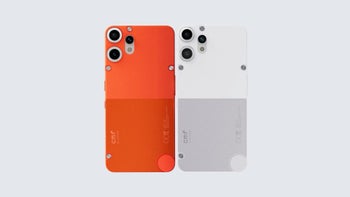Meet the Huawei P40, Pro and Plus: biggest camera sensor, longest zoom, fastest charging

The CEO of Huawei just took the stage and announced the long-rumored P40 series of flagships (and a midranger) in an online-only event that replaced the great Parisian fanfare due to the coronavirus scare (it rhymes!).
Yep, the rumors about record periscope zoom materialized, as well as the one for the quad-edge waterfall display design. Not only that, but Huawei managed to surprise us with the largest camera sensor ever placed in a modern phone (lest we forget, PureView 808 had a 1/1.2" sensor way back), and record wireless charging speeds that are faster than, say, the wired charging of the S20 series.
Key Huawei P40 Pro/Plus specs and features:
- Display: 6.6" 1200p OLED display with 90Hz "stable" refresh
- Camera: record 50MP 1/1.28" RYYB sensor
- Zoom: record 5x/10x periscope optical (Pro/Plus)
- Processor: Kirin 990 5G
- Battery: 4200 mAh
- Charging speed: record 40W (both wired and wireless)
- SIM cards: hybrid dual-SIM/memory card slot and an eSIM
Huawei P40 Pro and Plus specs and display
In fact, Huawei announced three phones - the P40, P40 Pro, and the P40 Pro+ - with the midrange P40 sporting a 6.1" 1080p display, and the other two having 6.58" diagonals with 2640x1200 resolutions. The displays have a front camera cutout for the dual 32MP selfie camera that has autofocus, and can do 4K video recording.
The two larger phones sport a beautiful "quad-curve" waterfall display that slopes not only towards the side frame, but also towards the top and bottom of the device. Now that's a "waterfall" screen, although Huawei calls Overflow Display. This has allowed Huawei to achieve a record screen-to-body ratio, and stuff 6.6" displays in incredibly compact for the diagonal bodies.
It looks and feels beautiful, especially when paired with the new matte Silver Frost finish that is still a hue chameleon, and the dual-tone camera island on the back. The phones are available in "nanotech ceramic" Ice White and Black (P40 Pro+) finishes with sapphire-like hardness, as well as Deep Sea Blue, and the excellent matte Silver Frost or Blush Gold colors (Pro)
The in-display fingerprint scanner has been greatly improved as well, managing to cover 30% more area than before, and be a third faster to unlock. Thankfully, Huawei is keeping the optical instead of Samsung's ultrasonic solution that behaves slower.
Last but not least, the trendy high refresh rate of the display is here as well, and Huawei thinks that 90Hz stable refresh is the perfect tradeoff between smooth visuals and battery consumption. Looking at the power-hungry 120Hz displays of the S20 series, we can't say that thinking is wrong.
Speaking of the battery, there are 4200mAh units (3800mAh for the P40) in both phones that can be charged with a 40W wired AND 40W wireless charging speeds which is a new record in topping up phones sans cable. The battery is slightly smaller than on the Mate 30 Pro, but Huawei tips that it chose the best combination of screen resolution and frugal Kirin 990 5G chipset to keep power draw the same.
Huawei P40 Pro and Plus camera zoom and hands-on samples
Perhaps the most interesting thing about the new P40 series is that even in these trying times for Huawei, they are again daring to go where no phone has gone before when it comes to photography.
Not only are the P40 Pro and Plus equipped with giant 50MP 1/1.28" camera sensors with RYYB pixel arrangement, but the Plus model is also kitted with a true 10x optical periscope zoom (as opposed to the heretofore 5x zoom record on phones like the P40 Pro, P30 Pro or the Galaxy S20 Ultra).
Not to be outdone by Samsung, Huawei also equipped a 100% of its camera pixels with phase-detection autofocus, for instantaneous continuous AF when shooting video and milliseconds in low-light scenarios. Instead of the Dual PD autofocus, however, Huawei uses an Octa PD solution for uninterrupted refocusing in all scenarios.
The dual 32MP front camera also comes with autofocus and 4K video recording, unlike many other competitors, and Huawei promises beautiful bokeh portrait shots with the second IR depth/gesture sensor. As for video, there is no 8K recording, but the 4K comes with a bunch of features and optimizations, as well as with optical and Audio Zoom technologies.
These specs alone should tell you a lot about Huawei's strive for excellence, and we shot a few quick hands-on shots with the P40 Pro to show you how clear the maximum hybrid zoom level is, and the amount of light the crazy big 50MP sensor is able to soak in during the night.
Huawei P40 Pro and Plus price and release date
The phones have both a hybrid dual SIM/memory card module, and an eSIM card inside for added flexibility wherever you are. Available in "nanotech ceramic" White and Black (P40 Pro+) with sapphire-like hardness, as well as Deep Sea Blue, and the excellent matte Silver Frost or Blush Gold colors (Pro), the phones will be released apart.
The Huawei P40 and P40 Pro will be landing as soon as April 7th starting from EUR 799 and EUR 999, while the Plus model that carries the 10x periscope zoom lens will appear in June for EUR 1399. Those prices clash them directly with the Galaxy S20 and Ultra, and the phones come at 8GB RAM and 128/256/512GB storage configurations for the P40 Pro, or 256GB/512GB for the P40 Pro+, respectively.










Things that are NOT allowed: